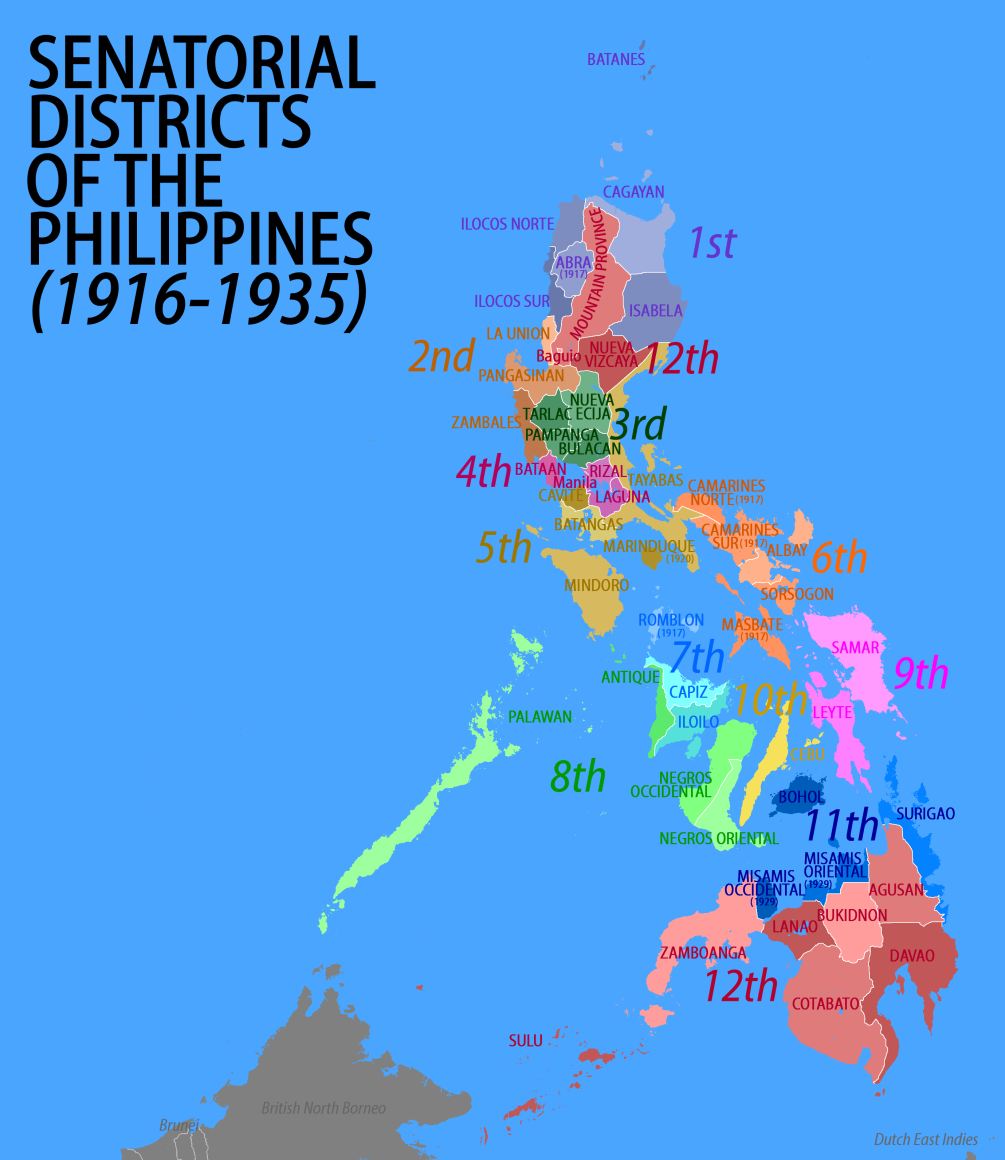Senatorial districts of the Philippines on:
[Wikipedia]
[Google]
[Amazon]
 The senatorial districts of the Philippines were the representations of the
The senatorial districts of the Philippines were the representations of the
List of senators – Senate of the Philippines
{{Philippine senatorial districts
 The senatorial districts of the Philippines were the representations of the
The senatorial districts of the Philippines were the representations of the provinces
A province is almost always an administrative division within a country or state. The term derives from the ancient Roman ''provincia'', which was the major territorial and administrative unit of the Roman Empire's territorial possessions outsi ...
of the Philippines
The Philippines (; fil, Pilipinas, links=no), officially the Republic of the Philippines ( fil, Republika ng Pilipinas, links=no),
* bik, Republika kan Filipinas
* ceb, Republika sa Pilipinas
* cbk, República de Filipinas
* hil, Republ ...
in the Philippine Senate
The Senate of the Philippines (Filipino language, Filipino: ''Senado ng Pilipinas'', also ''Mataas na Kapulungan ng Pilipinas'' or "upper chamber") is the upper house of Congress of the Philippines, Congress of the bicameral legislature of the ...
from 1916 to 1935.
History
The enactment of thePhilippine Autonomy Act
The Jones Law (, . 416, also known as the Jones Act, the Philippine Autonomy Act, and the Act of Congress of August 29, 1916) was an Organic Act passed by the United States Congress. The law replaced the Philippine Organic Act of 1902 an ...
(popularly known as "Jones Law") in August 1916 by the United States Congress
The United States Congress is the legislature of the federal government of the United States. It is bicameral, composed of a lower body, the House of Representatives, and an upper body, the Senate. It meets in the U.S. Capitol in Washing ...
provided for the creation of a bicameral legislature
Bicameralism is a type of legislature, one divided into two separate assemblies, chambers, or houses, known as a bicameral legislature. Bicameralism is distinguished from unicameralism, in which all members deliberate and vote as a single grou ...
consisting of a lower chamber (House of Representatives
House of Representatives is the name of legislative bodies in many countries and sub-national entitles. In many countries, the House of Representatives is the lower house of a bicameral legislature, with the corresponding upper house often c ...
) and an upper chamber (Senate). Until then the Philippine Commission
The Philippine Commission was the name of two bodies, both appointed by the president of the United States, to assist with governing the Philippines.
The first Philippine Commission, also known as the Schurman Commission, was appointed by Preside ...
held the executive power and some legislative powers over the American colony.
The system of government of the Philippines in its early years of transition to democratic self-government was deliberately structured to emulate the American model. The Philippines thus followed the American system of electing the members of the 24-seat senate
A senate is a deliberative assembly, often the upper house or chamber of a bicameral legislature. The name comes from the ancient Roman Senate (Latin: ''Senatus''), so-called as an assembly of the senior (Latin: ''senex'' meaning "the el ...
by district.
The districts were organized and numbered in a roughly north–south fashion, much like the present administrative regions. The first eleven districts were composed of established provinces, while the twelfth was composed of the provinces of the Luzon
Luzon (; ) is the largest and most populous island in the Philippines. Located in the northern portion of the Philippines archipelago, it is the economic and political center of the nation, being home to the country's capital city, Manila, as ...
interior and much of Mindanao
Mindanao ( ) ( Jawi: مينداناو) is the second-largest island in the Philippines, after Luzon, and seventh-most populous island in the world. Located in the southern region of the archipelago, the island is part of an island group of ...
– both of which were never fully administered by the old Spanish colonial government and designated by American authorities as "Non-Christian" areas.
The first to eleventh districts elected two senators each by popular vote. The two senators from the twelfth district were appointed by the U.S. Governor-General. The setup lasted until the establishment of the Commonwealth of the Philippines
The Commonwealth of the Philippines ( es, Commonwealth de Filipinas or ; tl, Komonwelt ng Pilipinas) was the administrative body that governed the Philippines from 1935 to 1946, aside from a period of exile in the Second World War from 1942 ...
in 1935, when the bicameral legislature was abolished, as the 1935 Constitution provided only for a unicameral National Assembly
In politics, a national assembly is either a unicameral legislature, the lower house of a bicameral legislature, or both houses of a bicameral legislature together. In the English language it generally means "an assembly composed of the repre ...
. However, when the Constitution was amended in 1940 to re-establish a bicameral Congress, members of the Senate had to be voted at-large, thereby effectively abolishing the district system.
List
See also
*Congressional districts of the Philippines
Congressional districts of the Philippines ( fil, distritong pangkapulungan) refers to the electoral districts or constituencies in which the country is divided for the purpose of electing 253 of the 316 members of the House of Representatives ( ...
* Lists of electoral districts by nation
References
External links
List of senators – Senate of the Philippines
{{Philippine senatorial districts
Senate
A senate is a deliberative assembly, often the upper house or chamber of a bicameral legislature. The name comes from the ancient Roman Senate (Latin: ''Senatus''), so-called as an assembly of the senior (Latin: ''senex'' meaning "the el ...
History of the Congress of the Philippines
Philippines
The Philippines (; fil, Pilipinas, links=no), officially the Republic of the Philippines ( fil, Republika ng Pilipinas, links=no),
* bik, Republika kan Filipinas
* ceb, Republika sa Pilipinas
* cbk, República de Filipinas
* hil, Republ ...